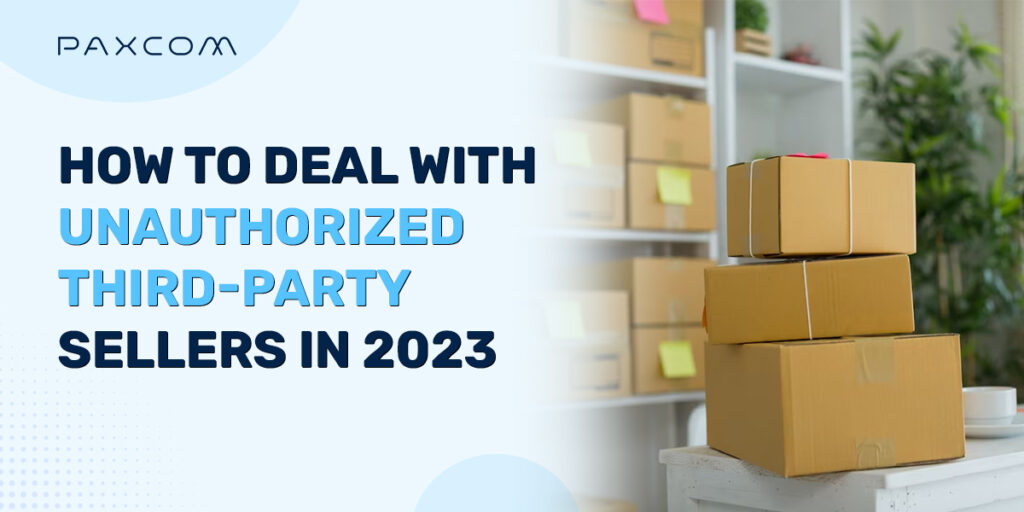Table of Contents
Introduction
Managing an eCommerce business across multiple channels presents a captivating and multifaceted venture. As your business expands, the possibility of encountering unauthorized third-party sellers becomes increasingly probable. If not identified or suppressed immediately, these unauthorized sellers could hamper your brand’s image and reputation online.
With the exponential growth of eCommerce, the threats and challenges that come with it cannot be overlooked. It is easy to create a seller profile on eCommerce platforms like Amazon, Walmart, and Flipkart, but identifying unauthorized sellers and preventing them from creating unnecessary hardships in your business. Locating and managing those sellers who are not following the MAP policies or are running a business under your name is critical for your brand’s authenticity.
Unauthorized Sellers: Impact on Brand Image and Business
Unauthorized sellers often mass purchase your product and list it across marketplaces. This results in a damaged brand image. Your products get listed across marketplaces at de-valued prices. Selling the product below the minimum advertising price gains them the buy box at the expense of your product and reputation.
As their foremost priority is making chunks of profit, they are less likely to be concerned about the customer journey. The consequences could be detrimental, as it will affect your reviews and ratings and post-product delivery care practices, to begin with. Customers’ trust and loyalty may dwindle, which could result in a drop in sales and a weakened market position.
It is high time for you to address the issues faced by the brand due to unauthorized sellers. Addressing these issues will not only safeguard the brand’s integrity but will also motivate the brand to free its business from any fraudulent practices.
Authorized and Unauthorized Sellers
Authorized sellers are listed with the brand and meet all the requirements of the brand. Purchasing the products from authorized suppliers helps you avoid last-minute hassles such as warranty issues, exchanges, and returns. On the contrary, UnAuthorized sellers undermine your brand’s reputation and policies and may even sell damaged or incomplete products.
Before heading to the strategies for dealing with unauthorized sellers, let’s first talk about the challenges and the unleveled field the brand faces.
- Due to the heavily discounted prices, sales at brick-and-mortar stores are affected. Products are sold at prices lower than the competition; these deep discounts downsize the brand equity and affect the profit margins.
- Some brands restrict selling their products through private channels, such as websites or apps, but unauthorized sellers violate the brand’s regulations and list those products on eCommerce platforms.
- One of the challenges that brands face is counterfeit products. The sellers sometimes source proxy products and sell them as a knockoff version under your brand name.
Identifying Unauthorized Sellers
The idea of skimming through the sellers sounds like a task in itself, as it requires too much workforce. Unauthorized sellers are present under multiple usernames; even if you find one and remove it, the other one could take its place. The whole process requires time, and if, amid handling all the tasks, you get swamped with the process of finding unauthorized sellers, you will get derailed from the core tasks.
To help you navigate through the process, our in-house SaaS product, “Kinator,” comes to the rescue. The digital shelf analytics software eases your tasks and saves you both time and manpower. The tool helps you identify unauthorized sellers through automation. Furthermore, Kinator is crafted to help you with the pricing and promotions of the products. Its real-time analytics feature also monitors the stock availability and visibility of the product. These functions together provide a much-needed headstart for the sellers and set them apart from the competition.
Dealing with Unauthorized Sellers
Unauthorized sellers pose significant challenges and can negatively impact your brand’s reputation. To effectively address this issue, we will outline key strategies for combating unauthorized sellers and their unfavorable practices, offering valuable benefits for your business.
- Audit the online presence of the brand at regular intervals
Monitoring your online presence regularly helps you monitor the listed products across several marketplaces. Kinator tracks the products and notifies the brand immediately regarding discrepancies. Once you have tracked down the unauthorized sellers, you can take stern action against them. Kinator automates this process for you and skims through the sellers regularly. It keeps you prepared for potential issues that arise over time.
- Establish authorized reseller agreements.
Form agreements with authorized resellers committed to upholding your brand’s standards. This enables you to maintain control over product distribution, ensuring that only trusted and authorized partners are selling your products.

Authorized Agreements
- A strict Minimum Advertising Policy is the way to go
A strict “Minimum Advertising Policy” needs to be enforced to help combat third-party unauthorized sellers. A specific price cap will prevent undercutting and maintain the value of the brand.
A strict mapping policy delivers on your strong objective of protecting the brand’s dignity while creating a level playing field for both the brand and the authorized sellers. By setting clear guidelines, you encourage compliance and discourage any practices that could harm your brand’s reputation or erode customer trust.
- Proactive Measures to Bust and Remove Unauthorized Marketplace Sellers
If you want to remove sellers from marketplaces, first draft the strategy and then take action. Marketplaces won’t unlist or block them if the seller doesn’t violate the platform’s policies. To get a seller blocked, collect evidence first, such as making a purchase and filing a formal complaint against the third-party seller. Amazon USA offers seller support for more hands-on assistance. With the help of Amazon’s Brand Registry program, brands can file claims against unapproved listings.
- Selective Distribution
Creating a secure environment and building healthy communication with the sellers is advisable. Through selective distribution, you will have a network of only those distributors and sellers who meet your brand requirements. You can encourage the sellers with exclusive discounts, early access, and incentive programs to maintain loyalty and transparency throughout. You can also restrict these sellers from selling outside the network except directly to end consumers.
- Take legal action when necessary

Legal Action against unauthorized sellers
You can also take legal action against the vendors if you feel things are getting out of your hands. This can include sending cease and desist letters, filing lawsuits for trademark infringement or unfair competition, or working with law enforcement to shut down illegal operations. It’s essential to consult with a legal professional to determine the best course of action for your specific situation. Legal action can be costly and time-consuming, but protecting your brand’s reputation and financial interests may be necessary. There are certain provisions for removing unauthorized sellers under the trademark law in the European Union and the UK.
Conclusion
By implementing these strategies, you can effectively mitigate the impact of unauthorized sellers on your sales, profitability, and brand image while retaining your loyal customer base. Kinator offers cutting-edge technology and solutions tailored to your needs to stay ahead of the competition in this ever-evolving landscape.
With Kinator’s advanced tools, you can proactively monitor your brand’s online retail presence and track the buy box status of your authorized sellers. This invaluable insight allows you to control your product listings, promptly identify and address unauthorized sellers, and ensure a seamless shopping experience for your customers.Book a demo or contact us at info@paxcom.com to experience an altogether different scenario in this eCommerce space.














